John Maxwell's well-known quote is certainly appropriate for the diamond industry, a sector with generational players who tend to resist change, sometimes stubbornly.
Analog-Digital Conversion (ADC)
The world's audio-visual industry was transformed by a sweeping change in just a few short decades. Vinyl records, audiotapes, and video cassettes (Google it, kids) underwent disruptive conversion to CD and DVD formats, ultimately becoming sharable digital files stored in the cloud, available on-demand. Today, with few exceptions, we consume recorded music and movies digitally but that didn't happen overnight - and it didn't happen everywhere.
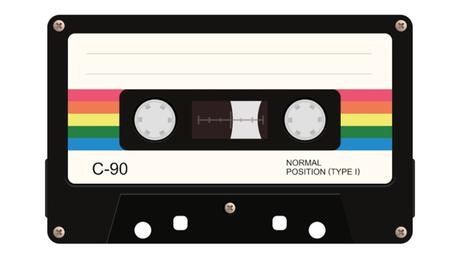
There are still vinyl record and tube amplifier purists who insist something gets lost in translation when music is converted from analog to digital signals. They're not interested in changing. They refuse to depart from the old ways.
I understand the appeal of music is deeply personal so I won't argue with the purists, but failing to accept change and growth means their choices will only become more and more limited as the world grows around them.

Digital Polished Sales
Polished diamonds have been sold online since the first days of eCommerce. What started as a trickle became a roar in 1999 when Blue Nile flooded onto the internet, listing thousands of stones owned by a variety of loose diamond producers and wholesalers.
We can credit digital diamond sellers for being among the first to pair attractive pricing with free shipping and no-risk inspection/return policies which have now become standard across most sectors in eCommerce. Today nearly 1 in 10 diamonds and jewelry sales happen online.

In October 2019 ALROSA, the world's largest diamond miner, teamed up with Sarine Technologies to explore the use of digital scans, analysis, and calculated polishing solutions for rough diamonds to their customers. The technology had existed for some time but hadn't yet been used as a component of rough diamond auctions, tenders, and sights.
Sarine Advisor Technology
COVID-19
ALROSA's plan was originally intended to permit assessment and pre-selection of choices prior to a traditional in-person rough tender - an auction where bids for rough parcels are submitted after a live examination. But in 2020 there was dramatic change as the world entered quarantine. Diamond mining came to a halt. Rough was still available for sale, but trading centers were unable to host traditional onsite, physical tenders. Industry giants like De Beers' were forced to cancel tenders (aka sights) entirely.
The global situation caused ALROSA to rethink its own March auction of special sizes. "Specials" are larger rough diamonds weighing over 10.8 carats a piece. These crystals are offered for sale one by one, as opposed to smaller rough which is traditionally packaged and sold in parcels. Instead of canceling those sales, ALROSA broke new digital record. They decided to offer the larger crystals using a digital tender.
Evgeny Agureev, Deputy CEO of ALROSA explained the decision in a March 2020 press release:
"Health of our employees and customers is essential for us. This is why we decided to cancel upcoming auctions and shorten those already in progress. The company is in contact with customers from different countries, considering different supporting measures. One of the opportunities is a digital tender. It will not replace the traditional trading model, but becomes a solution for those who are ready to work remotely right now. From our part, we will provide all the necessary information about our rough diamonds and will negotiate with customers on payment terms and logistics."
ALROSA provided online imagery and data to customers, including a 3D model of each special generated from scans, mapping the crystal's external shape and internal inclusions. 360-degree spin-videos of both external and internal features were also provided, along with details regarding color and fluorescence.

Rinse and Repeat
With no end to the pandemic insight, ALROSA continued stepping forward digitally as the year progressed. In May they offered over 800 rough diamonds in the 5.00 to 10.00-carat range to long-term customers via digital tender. This was the largest volume the company ever posted online. Here again, the tender conveyed detailed information on individual crystals - even though such weights are normally sold in parcels of multiple stones. This facilitated thorough assessment, planning, and cherry-picking by customers. In June ALROSA offered 700 more stones in the same weight category.
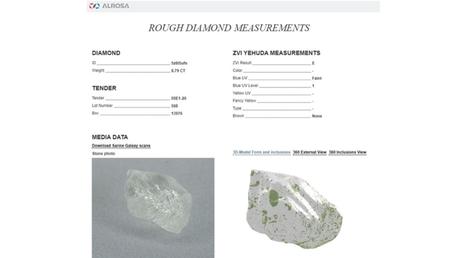
Others Follow
De Beers underwent a string of miscues and misfires to begin 2020. After canceling Sight #3 in March and suffering poor attendance at April's Sight #4, due to travel restrictions, they put a system in place where rough parcels are first sent to diamond trading markets like Antwerp, Hong Kong, and Dubai for in-person viewing and inspection and then hold the sights while accepting online bids.
At the same time, DeBeers' Group Auctions launched an online platform where registered buyers could begin making purchase rough diamonds online.
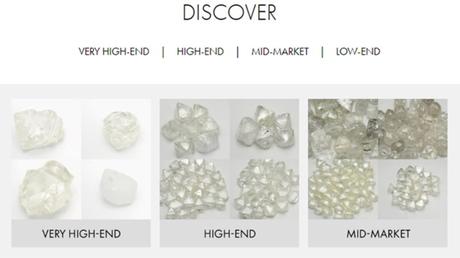
The pandemic stimulated similar evolution among other rough traders, introducing hybrid and fully remote tender opportunities for buyers:
- International rough diamond brokerage I. Hennig announced a "Virtual Broker" (VB) platform. Viewings continue to occur in Antwerp, observing social-distancing guidelines, but VB sales events allow suppliers and buyers to negotiate and close deals online at any given time without having to wait until the end of that event.
- In June 2020 Koin International launched "Virtual Viewer," offering sessions where Koin experts acted as the eyes and hands of clients in real-time using specialized equipment and technologies, including high-resolution video. Customers were able to view and review products at any time since sessions were recorded, permitting bidding, and buying from anywhere in the world.
Continuous Improvement
As the pandemic keeps surging and subsiding digital rough sales continue. At their fourth online auction of Specials in December ALROSA sold 80% of all available rough, a total of 185 crystals, to companies in Belgium, India, Israel, Russia, and the UAE for a total of $7 million. Of the $24 million in rough diamonds ALROSA sold in March, $5.5 million (23%) was attributable to digital auction revenue.
Just last month Sotheby's made digital history, selling an exceptional 101.38-carat pear-shaped Flawless clarity D color diamond for $12.3 million dollars - to be tendered in cryptocurrency.
Crypto-wow
Let's be clear. This is an exceptionally rare item. Fewer than ten 100 carat + examples have ever come to auction and only two of them were pear-shaped. When you couple this with the fact that cryptocurrency was accepted as payment, we have just experienced a landmark event in the history of the world's marketplaces. No other physical object approaching this value was ever publicly offered for sale with payment by cryptocurrency accepted.
The diamond's name, 'The Key 10138', was selected to represent the past, present future, reflecting the natural diamond's billion-year past, the transitions our world is undergoing at present, and the opening of an unprecedented door to the future.
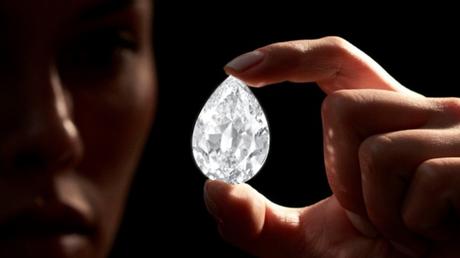
'Luxury Edit' Sales
This was the inaugural launch of Sotheby's 'Luxury Edit' sale series, using a new cross-category sales concept. The format encompassed diamonds, jewelry, watches, handbags, and even special sneakers, with the intent to appeal to an increasing number of collectors who combine these categories. In addition to 'The Key 10138,' the 101.38-carat Flawless clarity, D color pear-shaped diamond, the showcase offered a range of items spanning the F.P. Journe Tourbillon Souverain to a popular Hermes Himalaya Birkin and a Nike Air Force 1 1World CLOT Special Box. You can see the auction results here.
Digital Diamond Commodity
Hmm... What about the possibility of paying for a Sotheby's auction item with digital diamond crypto?
Earlier this year USA-based Diamond Standard and the International Gemological Institute received regulatory approval to offer the world's only market traded diamond commodity.
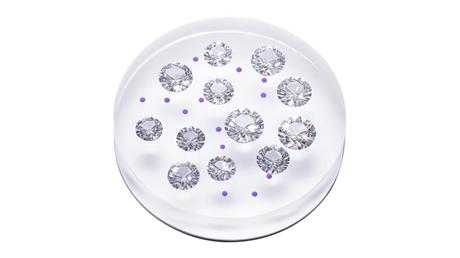
The $25 million initial offering of the Diamond Standard Coin was launched in February, enabling institutional and individual investors to trade and hold a fungible diamond commodity. Diamond Standard Coins each have the same market value and are being listed on commodity exchanges. The market price is determined by buyers and sellers, just like gold.
Initially, at $5,000 per coin, the Diamond Standard coin was up 14% by July and just under 17% as of August 15, 2021, with a value of $5,825.
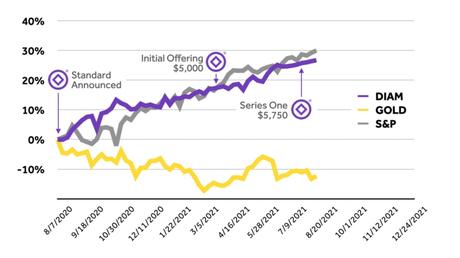
IGI was tasked with receiving, inspecting, and validating the authenticity of over 50,000 natural diamonds acquired through the Diamond Standard Exchange using automated market making and transparent bidding. IGI then assembled the diamonds and sealed them into transparent coins with a wireless computer chip. Finally, IGI uses Diamond Standard's specialized equipment to enroll the coins onto a blockchain, creating a regulator-licensed digital token that can be used for transactions.
Track the Diamond Standard Coin's Current Value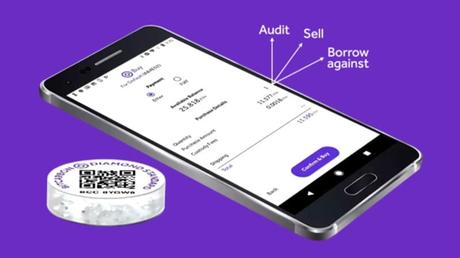
Digital Diamond Traceability
As we look to the future there is enormous positive potential for digital technology, in terms of traceability. More and more, conscious consumers want to know what their dollars are supporting, from aspects related to the environment to those involving human welfare. While the possibility of conflict rough emerging in legitimate channels is remote, origin tracing is still uncommon, and that needs to change.
The main confounder to applying blockchain style technology is that two chains must be created: (1) The first chain, tracking the raw crystal from mine to producer. (2) An entirely new second chain, tracking the polished diamond/s which came from the rough to market.
The Sarine Diamond Journey
Sarine, the same company that assisted ALROSA in the first-ever digital rough sales, has big aspirations in this area. They are working to cooperate with the miners (ALROSA, DeBeers' etc.) on scanning rough diamonds at the mine, followed by a lot of aggregation. The idea is a first scan that acts as "rough birth registration," mapping the rough's external and internal features. When that rough reaches a producer they can take a scan, access the Sarine library, and use digital recognition to match it with the registration scan. After production the diamond produced can be validated against its registration scan, creating traceability from the polished diamond back to its original rough crystal and mine of origin.
The advantage to this approach is that it doesn't matter how many hands a piece of rough passes through before it reaches the ultimate manufacturer. Any producer subscribed to the program can match their local scan with the rough birth registration scan and validate the polished diamonds produced. Ultimately, Sarine hopes to see QR codes linking a given diamond to a user-friendly digital report.
The concept is doable. The challenge will be implementation. While most players in the diamond industry already have scan technology, the miners will resist the burdens of extra training and time applied to millions of carats of rough output. That burden may ultimately be overcome by younger generations of shoppers and the rising demand for transparency.
Plus ça Change, Plus C'est La Même Chose
The diamond industry continues to maintain many traditions. Inspections and sales are largely still done face to face, whether the diamonds are rough, polished, or sold at auction.
2020 forced change to many aspects of our lives. We will probably never return to "pre-pandemic normal." It's likely that we'll eventually discard isolationist, impersonal, and inconvenient changes, but I'm confident that we'll carry positive, practical, and efficient evolutions forward.
Diamonds and jewelry are appreciated aesthetically. Emotionally. Symbolically. Those are things that don't easily translate easily to the digital world. Nevertheless, while total sales were down, online sales of diamonds and jewelry spiked by 22.5% in 2020.
Unlike music, there is no analog to digital converter for diamonds. Digital diamond sales will continue growing, but there will always be purists who refuse to depart from the old ways.
Like music, the appeal of diamond jewelry is deeply personal. For that reason, I won't argue with the purists, but their failure to grow likely means their choices will only become more and more limited as the rest of the world grows around them.

Written by John Pollard
Comments?
Did you know there are no inspection periods or returns allowed on diamond rough purchases? If you owned a diamond factory would you feel safe bidding for rough crystals based on scan data? Would you feel safe bidding on a million-dollar Sotheby's diamond digitally? Have you ever sold anything online? Did you get annoying questions from potential buyers? Would you keep a dinosaur as a pet? What would your other pets think?
More Reading
Learn how to define brightness, leakage, contrast, and scintillation on our page Diamond Performance Explained.
Take your diamonds on a brightness, fire, and sparkle test drive: Make Comparisons Like an Expert.
Get fast answers to any question: Ask our community of unbiased independent helpers.Ready to find your diamond?
Join PriceScope's Director of Education, John Pollard, and JCK News Director, Rob Bates tomorrow, Tuesday, 24th August 2021 at 1 PM CT for our first live webinar. Register here.